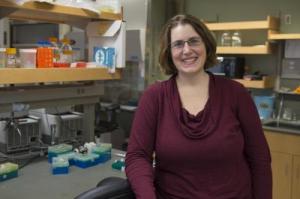Dec 19 2013
Physicists at the University of Chicago and the University of Massachusetts, Amherst, are uncovering the fundamental physical laws that govern the behavior of cellular materials.
 Margaret Gardel, professor in physics at the University of Chicago, is uncovering the fundamental physics laws that govern the behavior of cellular materials in collaboration with Jennifer Ross of the University of Massachusetts, Amherst. Their work is supported by a four-year, $800,000 INSPIRE grant from the National Science Foundation. Credit: Robert Kozloff/University of Chicago
Margaret Gardel, professor in physics at the University of Chicago, is uncovering the fundamental physics laws that govern the behavior of cellular materials in collaboration with Jennifer Ross of the University of Massachusetts, Amherst. Their work is supported by a four-year, $800,000 INSPIRE grant from the National Science Foundation. Credit: Robert Kozloff/University of Chicago
"We don't have any tools or formalism to think about these types of materials, and that's what we've been trying to go after," said Margaret Gardel, professor in physics at UChicago. Gardel and Jennifer Ross of the University of Massachusetts, Amherst, are supported in this work by a four-year, $800,000 INSPIRE grant from the National Science Foundation.
Gardel studies the building blocks of the cytoskeleton—the materials inside a cell that provide its shape and allow it to move—by extracting proteins from the cell and studying how they interact in vitro. "These materials are what makes living cells living materials and not dead materials," said Gardel.
Biological materials behave differently than non-living materials because, unlike conventional materials, they are not in a state of equilibrium—they constantly consume energy and do work with that energy. Studying the unique physics of such materials is interesting in its own right and could allow physicists to produce novel materials for applications outside the lab. "We are trying to take advantage of what is intrinsically new that these materials can do, that cannot be done by equilibrium material," said physics graduate student Patrick McCall, a member of Gardel's lab.
The NSF created the INSPIRE grants to fund interdisciplinary research that is innovative, and perhaps risky, but which could lead to big leaps in understanding. Gardel and Ross's research fits the bill because the scientists are working in uncharted territory—without theories to guide their way—as these materials are still poorly understood. "These systems are a part of nature that physics is not great at describing," Ross said.
Through their work, Gardel and Ross plan to catalog the phases of biological materials. Just as traditional materials can be in a solid, liquid, or gas phase, biological materials may have multiple phases where the materials behave in drastically different ways. Rather than temperature and pressure causing phase changes, the important variables to study might be the concentration or types of proteins in the mix.
One example of a phase transition in cellular material occurs with contractility, a quality that Gardel has studied extensively in her lab. Give biological materials the right conditions and they can contract, but change those conditions and suddenly contraction is no longer possible. Cells must contract to move, adhere to surfaces, and generate forces. Although contraction in skeletal and cardiac muscle cells has been well-understood for 60 years, finding a model of contraction for other types of cells has proven tricky. "That was sort of what I got stuck on when I started my lab," said Gardel.
Contraction in skeletal and cardiac muscle cells is generated by filaments made up of the protein actin in combination with the motor protein myosin. The myosin molecules walk along the filaments of actin, pulling the actin closer together and generating contraction along the filament. This model requires a precisely aligned network of actin and myosin, so that each tug causes the filament to get shorter, not longer. But this model does not explain contraction in other types of cells, which have disordered networks of actin. Research in Gardel's lab showed that the actin behaves like a rope, buckling out of the way when compressed, but resisting tension when pulled. This allows the whole network to compress, despite its disorder.
Gardel's research on contraction earned her a $450,000 Early Excellence Award from the American Asthma Foundation last year, which will allow her to study whether contraction in airway muscle cells can also be described by her model.
While Gardel's research has focused on actin, which is only one component of the cytoskeletal structure. Ross studies microtubules, which she describes as the "bones" of the cell, whereas actin is the muscle. "Much like the bones and muscles of your body work together to allow you to move, we believe the microtubules and actin cytoskeletons work in concert to enable cell shape changes and motility," said Ross.
Gardel's research brings the strategies of condensed matter physics (the physics of liquids and solids) to biological materials, with the goal of understanding how cells behave from the bottom up. The INSPIRE grant will allow Ross and Gardel to rigorously test cellular models and explore the underlying physics. "There are lots of theories out there about how these cytoskeletal structures are regulated, but very little quantitative physical data," Gardel said.